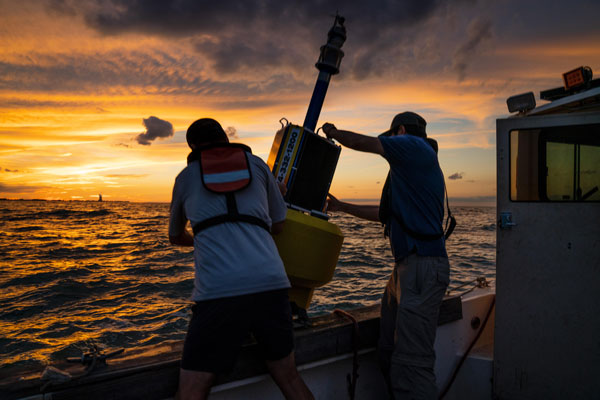Great Lakes ReNEW is a project so broad and ambitious that, at first glance, it might seem pie-in-the-sky. The nascent initiative being directed out of Chicago aims to develop technologies that would “turn waste into wealth” by extracting critical minerals from industrial wastewater to be reused in domestic production of EV batteries and other electronics. Presently, those cutting-edge technologies are largely dependent on imports of lithium, cobalt, nickel and other raw materials.
“ReNEW,” the organization proclaims on its website, “proposes a plan to use inclusive, streamlined innovation, workforce development and stakeholder engagement to drive a decarbonized, circular blue economy that would transform the Great Lakes region.” The project, officials say, will create jobs while fostering entrepreneurship, new businesses and export opportunities.
If that seems like a lot, the National Science Foundation clearly doesn’t believe the vision is over the top. In January, NSF announced that Great Lakes ReNEW will receive $15 million for two years and up to $160 million over 10 years as one of 10 inaugural Regional Innovation Engines. ReNEW’s winning proposal was one of 700 nationwide submissions.
“We take that as a mark of validation,” says Alaina Harkness, executive director of Current, the Chicago-based water innovation accelerator that’s leading the ReNEW coalition of more than 50 universities, research institutions and corporate partners that include Dow, Whirlpool, Exelon and American Family Insurance. In addition to providing the funding to getting the project launched, the award, Harkness tells Site Selection, suggests the far-flung vision “is not only possible but critical for our domestic supply chain, the security of our water resources and the vitality of communities in the Great Lakes.”
Yes, Harkness concedes, the plan is ambitious, “but we also have some of the best leaders in the country across every vertical. We’re not tackling it alone.”
A Lure for Major Investments
One of those leaders is Junhong Chen, lead water strategist at Argonne National Laboratory and a professor of molecular engineering at the University of Chicago’s Pritzker School of Molecular Engineering. Argonne has been at the forefront of developing new and more cost-efficient approaches for separating contaminants and other substances from water. Chen is NSF’s designated co-principal investigator and use-inspired R&D lead for Great Lakes ReNEW.
“Fresh water,” Chen says, “is critical to our economic prosperity, but it’s in limited supply. The way to get us beyond this challenge is to find ways to recycle and reuse the water.”
ReNEW’s larger mission, Chen tells Site Selection, is to attract sustainability-minded, water-heavy industries to the Great Lakes region.
“There’s an opportunity here to articulate an argument for the Great Lakes becoming a center of gravity for water-intensive manufacturers, not only because of our history of stewardship of the water, but now with the possibility of turning wastewater into freshwater in a cost-efficient way, while at the same time extracting critical minerals that are required for battery manufacturing.”
There’s a similar case to be made, says Chen, for extracting nutrients like phosphates and nitrates, thus keeping them out of the region’s waterways, putting them to use in fertilizers and thus elevating the Great Lakes as a draw for makers of those products. The project’s initial service area is to focus on Illinois, Wisconsin and Ohio, with Chicago, Milwaukee and Cleveland designated as anchor cites. The footprint is later to expand to cover Michigan, Minnesota and Indiana.
A cornerstone of Great Lakes ReNEW, says Harkness, will be to accelerate the development of an inclusive workforce pipeline to support the emerging ecosystem of water technologies.
“The water economy today is very under-representative of the communities across the Great Lakes that it serves,” she says. “We have a huge opportunity to diversify, which for us means starting earlier across STEM programs, diversifying the trades, diversifying the offerings that city and community colleges and working to make sure we’re diversifying our higher education as well. We see it as a massive opportunity.”
Over the first two years, Harkness says, “we’re aiming to reach 1,000 kids across the region with STEM programs focused on the blue economy and then 500 people trained in jobs that will be some of the first out of the gate. That includes everything from the early-stage pipeline all the way up through the postdoctoral fellows who will be supporting our research projects.”
Lake Erie Goes Digital
Great Lakes ReNEW intends to test technologies it helps to develop at the Lake Erie Watershed Testbed, part of another ambitious project that, in the space of a little more than three years, has managed to exceed its own expectations. When first profiled in the pages of Site Selection, (see “Could This Be the Dawn of the Water Belt?” Site Selection, May 2021), the Smart Lake Erie Watershed Initiative “was just a glimmer in our eye,” recalls Bryan Stubbs, president and CEO of the Cleveland Water Alliance, which has since converted Lake Erie, he says, into “the largest digitally connected freshwater body in the world.”
The Testbed’s network of smart buoys, sensors and monitoring stations spans some 6,500 square miles, allowing for “plug and play” testing of water technologies being developed around the world. Some 60% of technologies tested thus far, Stubbs tells Site Selection, are being forged by companies from overseas, including France, Israel, South Korea and New Zealand.
“I had no idea how fast it would take off,” Stubbs says. “We’re reviewing about 300 technologies per year, about 10% of which get accepted into training the Testbed.”
This spring, the Alliance launched the Freshwater Innovation Fund, a venture capital fund that aims to raise up to $25 million, targeting investments in up to 18 companies. Each selected innovator in water technology would receive funding ranging from $250,000 to $500,000.
“Technology-based economic development is the core of what we do,” says Stubbs, “getting new technologies into the market. Not every community can do this, but we’re doing it well and we’re running with it.”

